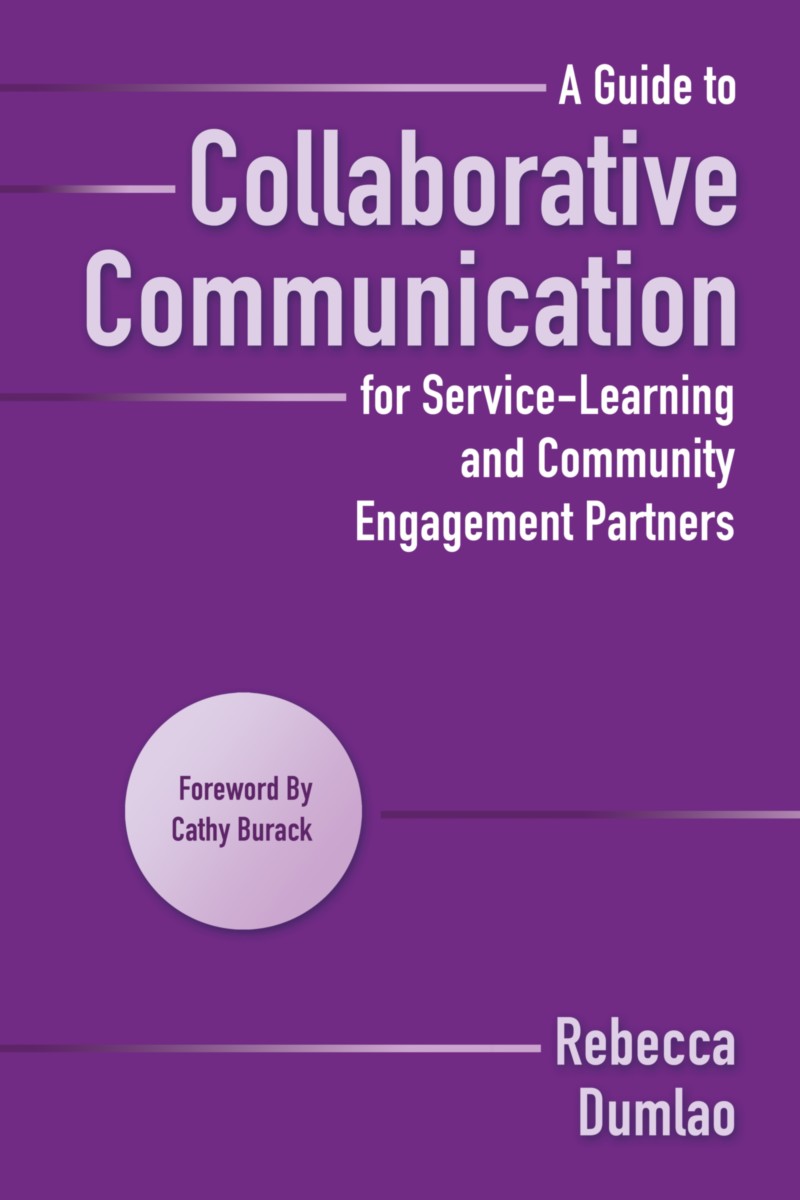Select an item by clicking its checkbox


A Guide to Collaborative Communication for Service-Learning and Community Engagement Partners
Additional Info:
This book focuses on partnerships at the most basic level of interaction – between two people as they work toward common goals. Interpersonal dynamics described in this book are intended to guide formal and institutional relationships between members of a community or community organization on the one hand and representatives from campus on the other. Collaborative communication principles and practices shared can form a foundation for individuals to build flexible, lasting relationships that will weather most challenges and sustain the larger partnerships of their respective organizations.
This book offers a conceptual framework of collaborative communication to build and sustain partnerships, recognizing that relationships change over time as the people involved and their circumstances evolve. Collaborative communication uses a repertoire of knowledge and skills that allow partners to make choices that fit their situation or context and to work through differences and challenges as they occur, to include managing conflict and navigating cultural differences. It further takes into account the different means of communication, whether face-to-face, using e-mail, text messaging, or social media. Readers will appreciate the numerous real world examples that illustrate and bring its key concepts to life.
This book is addressed to partners at all levels focused on community engagement and service-learning. It is intended for preparing college students to work more effectively in the community, as well as for workshops for community and campus members who work with service-learning students. It can equally be used in leadership workshops in academic and community settings. Scholars, students, or community members involved in community engaged research will also find useable ideas for their work.
The appendices offer an annotated bibliography of useful resources and provide readers with a repertoire of activities for building a collaborative communication repertoire. (From the Publisher)
Table Of Content:
Foreword, Cathy Burack
Acknowledgements
Introduction
Ch 1. Thinking About Ourselves and Our Partnerships
Ch 2. Community Engagement and Partnership
Communication
Ch 3. The Collaborative Communication Framework
Ch 4.Practices and Processesfor Collaborative Communication
Ch 5. Leadership in a Changing World
Ch 6. Navigating Cultural Differences while Preserving
Relationships
Ch 7. Dealing with Partner Differences and Conflicts
Ch 8. Creative Change for Future Community Engagement
Appendix: Learning Activities
Annotated Bibliography
References
About the Author
Index
This book focuses on partnerships at the most basic level of interaction – between two people as they work toward common goals. Interpersonal dynamics described in this book are intended to guide formal and institutional relationships between members of a community or community organization on the one hand and representatives from campus on the other. Collaborative communication principles and practices shared can form a foundation for individuals to build flexible, lasting relationships that will weather most challenges and sustain the larger partnerships of their respective organizations.
This book offers a conceptual framework of collaborative communication to build and sustain partnerships, recognizing that relationships change over time as the people involved and their circumstances evolve. Collaborative communication uses a repertoire of knowledge and skills that allow partners to make choices that fit their situation or context and to work through differences and challenges as they occur, to include managing conflict and navigating cultural differences. It further takes into account the different means of communication, whether face-to-face, using e-mail, text messaging, or social media. Readers will appreciate the numerous real world examples that illustrate and bring its key concepts to life.
This book is addressed to partners at all levels focused on community engagement and service-learning. It is intended for preparing college students to work more effectively in the community, as well as for workshops for community and campus members who work with service-learning students. It can equally be used in leadership workshops in academic and community settings. Scholars, students, or community members involved in community engaged research will also find useable ideas for their work.
The appendices offer an annotated bibliography of useful resources and provide readers with a repertoire of activities for building a collaborative communication repertoire. (From the Publisher)
Table Of Content:
Foreword, Cathy Burack
Acknowledgements
Introduction
Ch 1. Thinking About Ourselves and Our Partnerships
Ch 2. Community Engagement and Partnership
Communication
Ch 3. The Collaborative Communication Framework
Ch 4.Practices and Processesfor Collaborative Communication
Ch 5. Leadership in a Changing World
Ch 6. Navigating Cultural Differences while Preserving
Relationships
Ch 7. Dealing with Partner Differences and Conflicts
Ch 8. Creative Change for Future Community Engagement
Appendix: Learning Activities
Annotated Bibliography
References
About the Author
Index